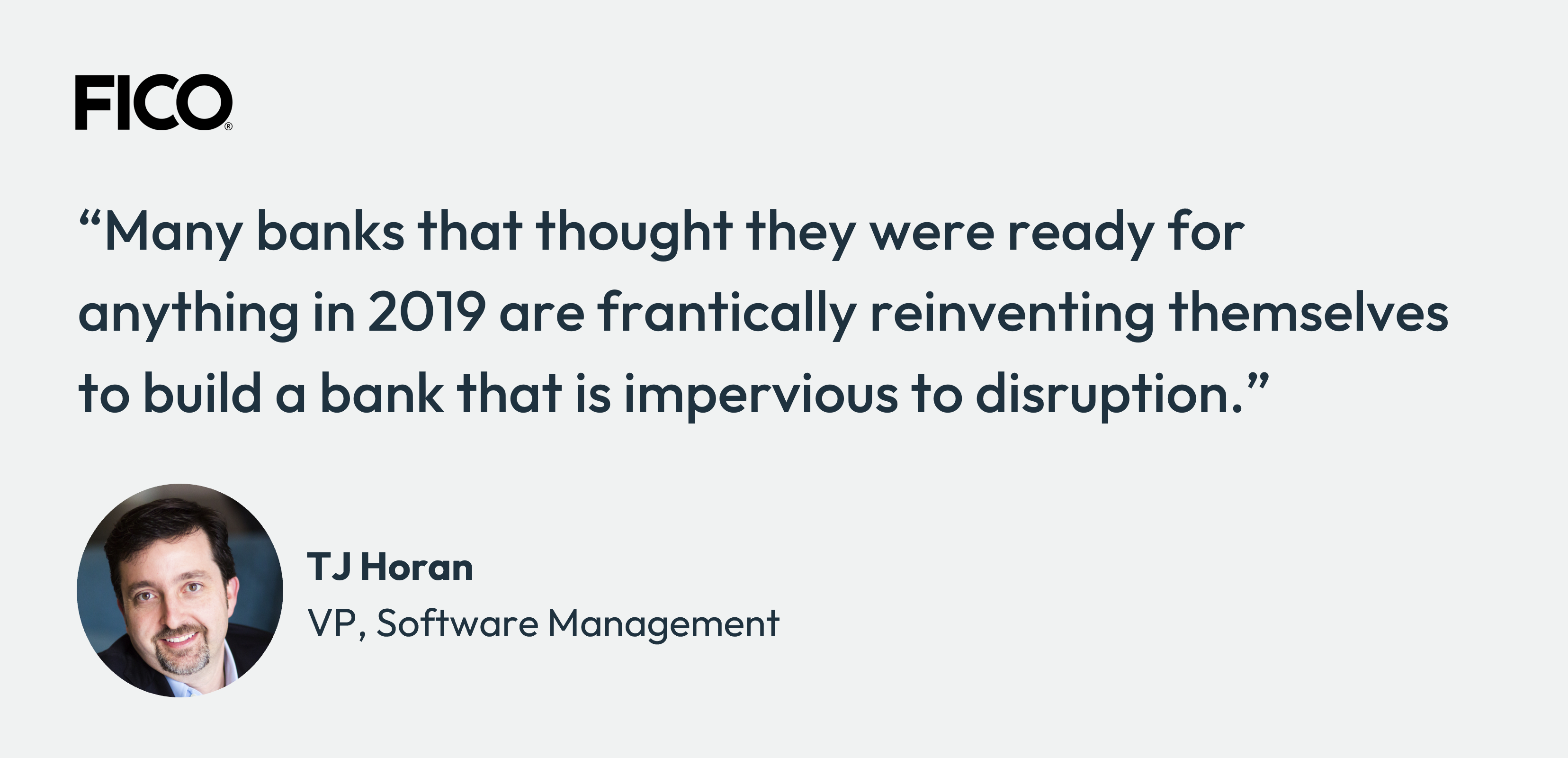Six Steps to Growth in a Global Economic Squeeze
Learn how banks and other financial institutions can use personalization to drive growth in spite of global economic uncertainty

Right now, we’re all wrestling with the squeeze on household incomes and rising inflation. For instance, the last time I went out to the driving range for a practice session, I was unpleasantly surprised to see that the cost for a bucket of balls had skyrocketed beyond what it was at the start of the global pandemic.
While it may seem like a relatively trivial observation about a modest discretionary spend on trying to improve my game, it also reflects the impact the global economic squeeze is having on every aspect of day-to-day life. Plus, there was also a wait for a spot on the range, an indication of all kinds of market forces at work in what is a relatively short period of time.
Looking at the bigger picture, banks, lenders, financial institutions, industry and commerce are all now facing the same challenges — on a macro scale. I’m curious as to how they balance their goals of delivering growth while managing the headache of rising interest rates, inflation and tightening budgets.
They’re also operating against an increasingly competitive backdrop amid consumer expectations for faster, smarter, suitably tailored and personalized experiences. But there are numerous routes to delivering personalization. It extends from relatively straightforward structured marketing campaigns to more sophisticated event-based automated approaches, all underpinned by AI, analytics, machine learning and customer journey orchestration.
The critical challenges have now concentrated many boardrooms’ thinking around the need to step up the pace of investment in this vital area.
Resilience Is Everything
The past 12 months have been choppy for us all. Despite many countries getting back on a path to a normalcy of sorts, the war in Ukraine, rising interest rates, inflation spikes and an ongoing squeeze on household incomes have continued to hamper growth.
During the past decade, following the financial crisis and last big economic squeeze, financial institutions mainly focused on rebuilding resilience, increasing capital, mending regulatory fences, investing in digitization, and achieving productivity and efficiency gains. Those that did are set to continue to do well because, once again, resilience is everything.
Divergence as a Strategy
Decisive strategic commitments to digital investments made today are likely to separate the leaders from the also-rans in the race for value within the next two to five years. It will also put financial institutions in a prime position to flourish in the evolving banking sector.
Success hinges on banks’ capabilities to serve their fastest-growing and most profitable customer segments. During the past 15 years, the US has seen revenues from middle- and low-income households squeezed, while small and medium-size enterprises (SMEs), which represent one-fifth (about US$850 billion) of annual global banking revenues, are predicted to grow by up to 10% annually during the next five years.

But the profits of banks in this segment vary significantly, partly because of highly varied credit quality and differing risk appetites in the portfolio. Finding the optimal balance between providing a great customer experience and managing the cost-to-serve has also proved tricky. As a result, many banks have not prioritized SMEs — forsaking vast potential value and leaving many sole traders and small business owners feeling like they are being ignored.
Many banks that thought they were ready for anything in 2019 are frantically reinventing themselves to build a bank that is impervious to disruption. Summarized below are six relatively quick steps to success.
1. Customer Ownership with Embedded Digital Financial Services
Companies like Amazon, Netflix, Starbucks, Apple, Google and Spotify among many others, have taken “traditional” customers services and transformed them into digital experiences that are now embedded in our daily lives. Amazon knows what we want often before we do, Netflix posts viewing recommendations that continually hit the button, while Starbucks creates bespoke gourmet coffee menus for every loyalty card-holding customer.
Now consumers expect the same from financial services. We all know our data has value — but the exchange of personal information comes at a price. Banking's still regarded as being relatively slow to fully leverage or deliver on the potential personalization offers.
And it's missing a costly trick, given the potential revenue opportunities it could deliver. There are multiple routes in — from real-time Open Banking data overlaid with AI insights, to personalization through fintech partnerships. The existing, underlying elements are also there — from the checking account and the personal loan to the POS deferred payment option — but they are a less visible, a seamless part of a broader digital experience.
2. Bring Customers into Your Ecosystem
By connecting them with other services and building a dynamic and distinctive customer experience, they can enjoy comprehensive value-added services for everything from household insurance to leisure, travel and fine dining.
Personalized analytical insights are also a fast route to customer engagement and in a virtuous cycle, they tell the bank or fintech more about customer behaviors and needs. Canadian banking giant RBC’s AI-powered financial assistant app NOMI Budgets offers users cash flow forecasts that take into account loan installments and subscription services, while also applying deep learning techniques to customers’ typical transaction habits. But there are many other big names such as Barclays, Lloyds, Santander and Nationwide, which also offer options for tracking spending on the go.
3. Efficient Models That Drive Growth
Brazilian banking giant Bradesco increased its digital transactions by more than 60%, thanks to real-time onboarding. Banco Bradesco was founded in 1943 but has since grown to become the second-largest private sector bank in Brazil by assets, with 74.1 million customers and 36.3 million account holders. It opted for FICO Platform to create a comprehensive real-time digital credit solution that has revolutionized the customer journey with instant decisions and optimized pricing. Known internally as Brain (Bradesco Intelligence in Business) the initiative has reduced the time taken to put projects into production and directly introduced more consumers to digital solutions, increasing digital transactions by more than 60% at the height of the global pandemic. Bradesco has also subsequently increased credit line revenue and the number of users by 15%.
Future-proofed business models are less dependent on financial reliance on interest rates and more focused on value-added services that deliver greater customer interaction and alternative income streams. Businesses like payments or wealth management have a natural advantage, because they gather fees without involving the balance sheet. But for banks it’s both a challenge and opportunity as they look to leverage income from a sizeable customer base, with a multitude of value-added services. The pioneers are already pursuing expanded financial ecosystems.
4. Continuous Innovation, Fast Go-To-Market, Technology and Talent
For traditional banks faced with more agile and digitally advanced competitors, the challenge can seem daunting. And the clock is ticking. As technology and digital adoption evolves, these lean new-to-market competitors — as well as the big tech firms — appear to be positioned to continue their upward divergence.
An optimist would note banks’ strong and sizable balance sheets and capital positions, coupled with high levels of trust backed up by decades of customer relationships. Ordinarily, these types of firms would seem able to see off any competitor. But a realistic view would be somewhere in the middle, with high-street banks obliged to emulate all or some of the leaner FinTechs’ approaches.
There are still plenty of opportunities for the innovators. A case in point is OCBC Bank, which opted for FICO technology to help approve mortgages within 60 minutes or less. Despite being developed and deployed at the height of the global pandemic, when face-to-face meetings were barred, US$700m in loans were signed-up, enabling the bank to maintain strong business growth. The platform went on to become a hugely efficient digital channel for nearly one in three (30%) of its loan approvals.
Outside of banking, motoring giant Volvo blazed a trail via its vehicle subscription service Care by Volvo, which slashed application decisions from three days to a matter of seconds. It opted for the FICO Platform to help digitize and accelerate customer onboarding. Thanks to automation, Volvo cut the credit check process on applicants from three days down to seconds. It has now achieved its goal of real-time decisions for more than 80% of applications, with straight-through processing. The FICO-powered solution is now being extended beyond Care by Volvo to all digital sales and many new electric vehicles as the Volvo Digital journey continues.
5. Speed and Scale
Scale matters more than ever as banks look to compete on technology. Most IT investments tend to involve a fixed cost that makes them cheaper over a higher asset or revenue base. The initial impact of scale is this ability to bring marginal costs down as an organization gains operating leverage with consistent increase in size. But there are greater benefits than simply cost cutting, as digital scale begins to deliver the network effects of mass platforms offering everything from special offers, peer-to-peer payments, to lending, instant mortgages, near to real-time alternative deals and next best offers, among many other applications.
The next few years are crucial for any bank with aspirations to land on the right side of the divergence described in this report. Not only is there simply no value to waiting, but also history shows a pattern in which institutions that take bold steps toward growth in the first years after a crisis generally hold onto those gains for the longer term.
Despite the likely impact of economic disruption ahead, there are still plenty of golden opportunities for innovation and bold strategic decision making. It’s simply a matter of thinking outside the box and adopting a combination of analytics, automation and applied intelligence.
Learn More
- Watch Digital Jane – Freshly Brewed Rewards, Fuelled by FICO Platform
- Read the post Even in a Crisis, the Best Collections Strategy Is to Avoid Collections
- Find out why digital-first means thinking like a marketer
- Read more on the regulatory background to the IFRS 9 learnings on models and operations
Popular Posts

Business and IT Alignment is Critical to Your AI Success
These are the five pillars that can unite business and IT goals and convert artificial intelligence into measurable value — fast
Read more
FICO® Score 10T Decisively Beats VantageScore 4.0 on Predictability
An analysis by FICO data scientists has found that FICO Score 10T significantly outperforms VantageScore 4.0 in mortgage origination predictive power.
Read more
Average U.S. FICO Score at 717 as More Consumers Face Financial Headwinds
Outlier or Start of a New Credit Score Trend?
Read moreTake the next step
Connect with FICO for answers to all your product and solution questions. Interested in becoming a business partner? Contact us to learn more. We look forward to hearing from you.
